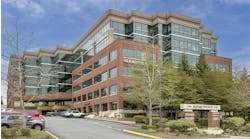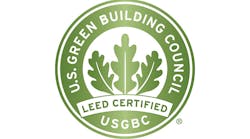MILWAUKEE — The first casino hotel to achieve LEED Gold certification in the state of Wisconsin, Potawatomi Hotel & Casino, placed priority one on its sustainability efforts, and the goal was to become one of the premier sustainable developments in Milwaukee. The hotel at Potawatomi Hotel & Casino opened in August 2014 and announced its LEED Gold Certification on Earth Day 2015.
The new 19-story, 350,000-sq.ft. casino hotel features 381 hotel rooms, including 16, two bay suites and one Presidential Suite, 15,000-sq. ft. of meeting space to support the recently renovated 32,000-sq.ft. Expo Center, an outdoor patio roof deck, a new full service restaurant and kitchen, a coffee shop, a concierge lounge and back of house office and support areas.
“While obtaining LEED Gold certification is a significant achievement, the effort to obtain this certification was not about recognition,” said Mike Goodrich, Potawatomi Hotel & Casino general manager. “Our goal was to advance sustainable business practices, which has been a long-standing tradition of the Forest County Potawatomi and a key focus at the casino for years.”
With the help of the property’s design firm Cuningham Group Architecture, Inc., the construction management team of Greenfire Management Services, the Gilbane Construction Co., the engineering firm EXP U.S. Services Inc., mechanical contractor, Butters-Fetting Company Inc., and plumbing contractor, J.F. Ahern, many steps were taken to ensure the property would achieve LEED designation.
The HVAC and mechanical design was a major contributor toward LEED certification. One example, through the work and installation of mechanical contractor Butters-Fetting Company Inc., excess heat from the nearby Forest County Potawatomi Community Renewable Generation power plant offsets the need to burn natural gas for hot water, and is piped back — through the aid of Bell & Gossett pumps — and cycled through a heat exchanger located at the mechanical plant in the casino.
Assisting in picking up the load, a Trane air-cooled chiller, added to the existing casino mechanical plant, uses variable frequency drives (VFDs) to modulate the compressors, which helps keep electrical expenses down.
According to Dan Braden, project manager and estimator, Butters-Fetting, in addition to three boilers already in place at the casino, a new Bryan RW 2100 boiler was installed. The boiler features 25 million BTU capability with “super” high turndown ratio.
Inside the rooms, energy consumption is managed through innovative technology and conservation techniques guests experience as soon as they enter their rooms. When a hotel room key card is entered, the room’s thermostat senses activity and adjusts the room temperature accordingly.
With plumbing installed by J.F. Ahern, the hotel rooms feature low-flow water fixtures, which include Kohler one-piece 1.28 gpf toilets, and common areas feature high-efficiency Moen flush valves.
Construction of the hotel had to be accomplished while the adjacent casino kept operating. In addition to feeding the 19-story hotel with cast-iron pipe, Ahern’s Jim Jarvis, executive vice president, northern Wisconsin region; Jason Brenner, project manager; and Mark Hersey, general foreman worked together to meet the challenge of site logistics.
“We needed to deliver prefab setup for all rooms while the casino was running at full operations,” said Jarvis.
“The structure was going up as the plumbing installation was happening. We were installing and designing at the same time,” said Hersey.
Also notable on the project was brine reclamation through the installed water softener system. Brine reclaim reduces waste while increasing cost savings.
“The building owner is able to reduce sewage flows and save on wastewater charges in conjunction with brine reclaim,” said Brenner.
All of the trade work was coordinated through 3D CAD modeling software “so installation and coordination was made easier before guys got to their areas,” said Braden.
In addition to sustainable HVAC and plumbing design, the hotel features:
• LED lighting throughout the property, which has controls in place to limit usage as needed.
• Sensors gauge how much natural lighting is coming through the hotel’s large windows during the day, keeping energy consumption down.
• An on-site storm water management system is in place in which a detention basin is built under the parking garage to hold stormwater from the garage and hotel.
• Building products were made from locally produced or recycled materials whenever possible.
• Wood products from local Native-owned forests were used throughout the property.
As a result of a tighter building envelope, glazing, and cutting-edge HVAC concepts, “the heating and cooling load came up less than anticipated,” said Braden.
Regarding the hotel’s interior design, the lobby gives the feel of walking through a modern, stylized forest that features energy efficient, color kinetic light fixtures along the edges of custom “tree” columns and within the “leafy canopy” ceiling features.


